The Church
Perched onto the gentle slopes leading to the upland of Pizzorne, the Pieve of San Giorgio di Brancoli looks onto the last stretches of the Serchio valley. From the church square, the gaze gets lost over the plain of Lucca; when the air is clearest, even the bell towers standing within the city walls of Lucca can be spotted. The imposing campanile, next to the façade, is the sentry to an edifice whose extraordinary richness is still revealed by its medieval features. The overall classicism conveyed by its basilical plan and plain wall faces were inspired by the Sant’Alessandro of Lucca, built as the Pieve in the second half of the 9th century, in the atmosphere of spiritual reform of the church promoted by the bishop Anselmo da Baggio, later become pope under the name of Alexander II. The sculptural decoration of the church is unique as to its quality and exhaustiveness, from architectural sculpture, coeval to the building, to the most rich presbyterial fittings, dating from the subsequent century.
Description »
The church has got a basilical, three-nave plan with semicircular apse, without a transept. On either side, starting from the façade, arcades are supported by a semi-pier, two columns, a pier at the presbytery chancel, a column and a semi-pier, mostly surmounted by Corinthian capitals, except for the pier capitals – one with angels, another one of a composite type – and the capital of the second column on the right, showing human and animal protomes at the corners. Figured capitals coming from the pieve are conserved at the Museo Nazionale di Villa Guinigi, Lucca. The wall face in white limestone of Santa Maria del Giudice presents an extraordinary homogeneity: ashlars are perfectly squared and regularly laid, with a pseudoisodomic technique alternating courses of different thickness. In the apse, a series of Lombard bands is supported by figured corbels. The portal lintel on the southern side, instead, is decorated with an enigmatic, big-handed character. The massive campanile is built on a wide, two-step base, set against the left part of the church façade. Only the lower part, showing a masonry in white and grey limestone ashlars, may be dated from the 11th century.
History »
The church of S. Giorgio became a pieve in 1097, when the whole area (where Matilda of Tuscany used to reside) knew a remarkable population growth, acquiring a new, key role on the socio-political scene of Lucca and becoming, at the same time, a territory closely dependent on the bishopric. Until 1097, the whole Brancoleria region depended from the pieve of Sesto di Moriano, as confirmed by the first document mentioning S. Giorgio in 772. Thus, a church already existed in the early Middle Ages, although no vestiges may be associated to the primeval structure. The present building was probably erected on the occasion of the rise to the rank of pieve, while the lower part of the bell tower may be dated from a few decades earlier, as the masonry technique suggests a dating from the first half of the 11th century.
The importance of the pieve did not decrease during the 13th century (in the first half, significant works were carried out on the interior fittings), thanks to the geographic position dominating the entrance to the Serchio valley and the consequent role in the political fights of those decades for the conquest of Garfagnana. On the contrary, 14th-century documents report increasingly difficult issues related to the need, not always recognized, to perform maintenance and restoration works on the building.
Works »
The pieve of S. Giorgio guards some important works of medieval age. The small columns used to support the altar – a likely residue of earlier presbyterial fittings – are coeval to the church construction, between the late 11th and the early 12th centuries; they may be assimilated to capitals of columns and piers, in the same way as a stoup with human protomes, which was present in the church until a few years ago, signed by the sculptor Raito. Almost a century later, between the end of the 12th century and the beginning of the 13th, a sculptor of Guidetto’s school, who had signed the façade of Lucca Cathedral in 1204, made the presbytery chancel, the baptismal font and a carved stone pulpit resting on four columns, of which two are supported by wonderful groups of fighting lions.
The church also hosts a painted cross dating from the end of the 13th century, as well as an Annunciation by Giuliano di Simone (second half of the 14th century) at the head of the left aisle, the only fragment left from a more extended frescoed decoration.
Restorations »
In post-medieval centuries, the church underwent some changes later cancelled by works performed during 19th and 20th restorations, aiming to reset the previous status. In particular, false vaults were built to conceal the wooden trusses; the presbytery chancel was dismantled; it was never mentioned on the occasion of pastoral visits while, in the 19th century, it was reported as reused in the flooring for the presbytery area.
Following 1923’s earthquake, the structure underwent consolidation works, including the partial reconstruction of the bell tower, starting from the first mullioned window. In 1937 new works were started; they would be completed only after the end of World War II. During such works, constructions set against the apse were removed, the presbytery chancel was reinstalled and damage caused by artillery to the bell tower, the roof and the side walls was repaired.
Bibliography »
M.T. Filieri (a cura di), Lucca, Milano 2000, pp. 176-178.
C. Taddei, Lucca tra XI e XII secolo: territorio, architetture, città, Parma 2005, pp. 295-311.
G. Tigler, Toscara romanica, Milano 2006, pp. 272-273.
Location





















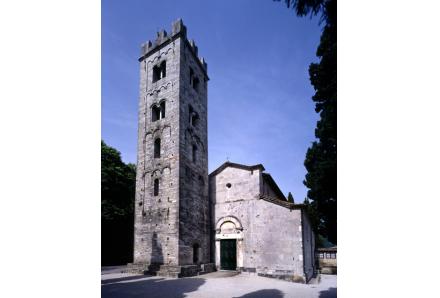


 Apse
Apse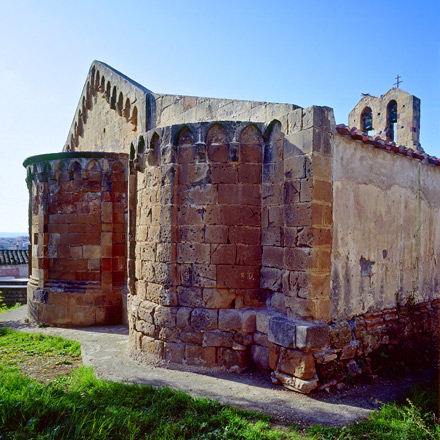
 Rusticated ashlar
Rusticated ashlar Pseudo-isodomic technique
Pseudo-isodomic technique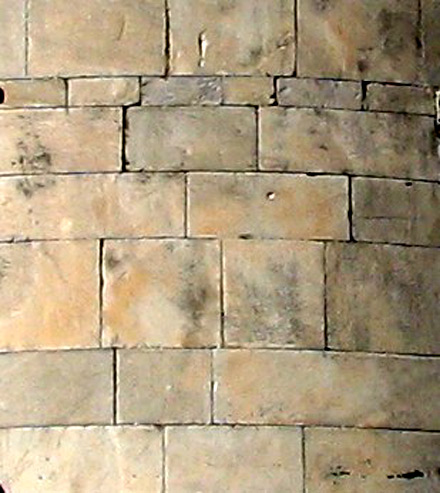
 Fresco
Fresco
 Capital
Capital
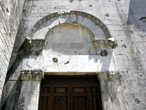 Architrave
Architrave
 Nave/Aisles
Nave/Aisles
 Portal
Portal
 Two-light mullioned window
Two-light mullioned window
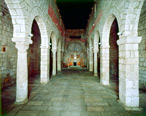 Cathedral
Cathedral
 Pulpit
Pulpit
 Protome
Protome





